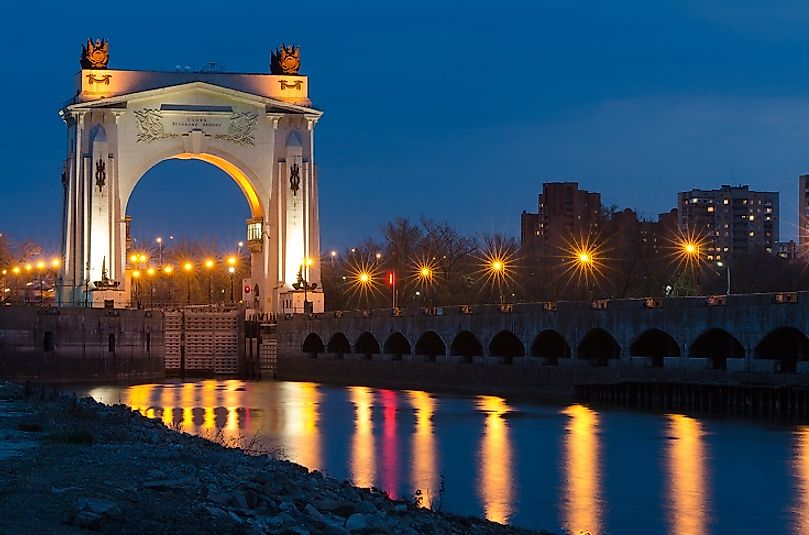Where Is The Volga-Don Canal?

5. Location, Role, and Function
The Volga-Don Canal is a hydro-technical construction of 101 kilometers long, and stretches between the two major rivers of Middle Russia and the Caspian plains, namely the Volga and the Don Rivers. What makes the channel so unique is that the water thresholds the canal consists of should rise high up and overcome the mark of 88 meters, which is the altitude difference between these two river valleys. This issue is solved by 13 gateways. It takes 10 to 12 hours to traverse the waterway from the city of Volgograd to the town of Kalach-on-Don. The journey begins in the backwater of the Volga and goes through the valley of the River Sarpa. The highest point of the watershed is the Gateway Number 9. Right after that, the relief is gently lowering to the Don. Then, the Volga-Don trip ends near the town of Kalach-on-Don, which is located on the left bank of the Tsimlyansk Reservoir.
4. History and Construction
The first attempt to connect two large and strategically important rivers with navigable channel was undertaken in the 18th Century by Peter the Great. But only by 1948, under the Soviet Union, was the channel project finally ready. It was based on a draft made by outstanding hydraulic engineer Nestor Puzyrevsky. In terms of complexity, the Suez Canal had seen comparable construction work, but it took more than thirty years for Suez to be built, and the Panama Canal took more than twenty years, while the Volga-Don was finished in an astonishing 4.5 years. The channel construction employed eight thousand units of heavy duty vehicles. Exclusively for the canal project the giant walking drag lines were created, having a bucket capable to room a middle-size car, and boom removal of sixty-five meters. Three categories of workers took part in this great endeavor. These were the German prisoners of WW II, Soviet prisoners, and civilian workers.
During the canal's construction, about one hundred and sixty thousand Soviet prisoners passed through and labored. They were divided into two categories, either political prisoners or criminals. All stones on the canal embankment were lined by hand. The tamping of channel bottom too was done by man-force alone, and prisoners used to embark on "timber rafting". Therein, they would be standing in cold water and guiding the heaviest logs. The hardships of work on the channel construction indicated by the fact that for each area of construction work, another cemetery was built along the. Civilians from across the country freely chose to work on the channel project as well, and there had been more than half a million civilian employees involved in the construction works. They lived and worked in equal living conditions as those of prisoners, occupying the same barracks, and worked four years without a single day off.
3. Significance as a Waterway
The navigation period on the Volga-Don Canal lasts for eight months. During this time the channel can take up to 5,000 vessels with a maximum capacity of five thousand tons. Presently, the channel's capacity is up to 16 million tons of cargo per year, mainly as a conduit for oil and oil products. In 64 years of operation, the channel has been able to transit more than 400 million tons of cargo and about 5 million human passengers.
2. Habitat and Biodiversity
A unique lake of lotuses could be found in the Volga valley adjacent to canal's watershed. The growing floodplain oak forests and meadows occupying the banks of the canal. The migration route of birds runs through the Volga-Don canal, and in the lower reaches of the Volga river fish spawning occurs. As for the forest inhabitants the most widespread are raccoon dogs, badgers and wolfs. In the steppe zone the famous artiodactyl is the saiga antelope, as well as the little deer. Mammals are represented by rodents, predators, and large ungulates. The region is especially rich in rodents, which are found numbering 32 species among them.
1. Maintenance, Operations, and Future Plans
Three gateway passages in the beginning of Volga-Don canal are located within the borders of the Volgograd city. The "steep climb" starts seven kilometers away from the third gateway. At the stretch of nine kilometers gateways allowing ships through with each next step rising a bit and eventually reaching a point of 50 meters above the Gateway One. Moving on from the city of Volgograd the vessels should first climb 88 meters on the Volga gateway stairs, then go down to 44 meters on the Don gateway stairs. To fill sluices with water three pumping stations are used, capable to create water pressure in gateways of 10 to 13 meters each. Presently the nations of China, Kazakhstan, and Russia are developing a project to build a second line of the canal, which result in an increase of its capacity two-fold, reaching 30 to 35 million tons per year. This path is planned to be used for the transit of goods by sea from China, as well as for the delivery of oil products from the Caspian Sea into Europe.











